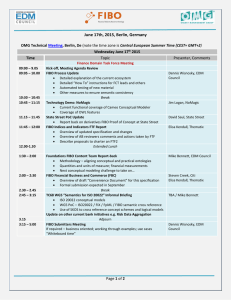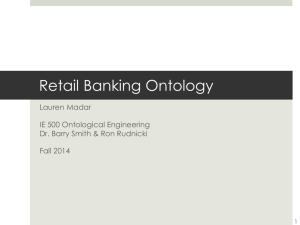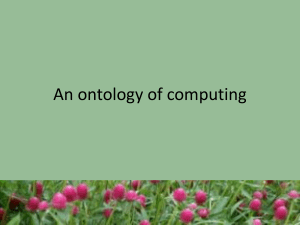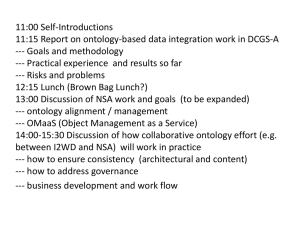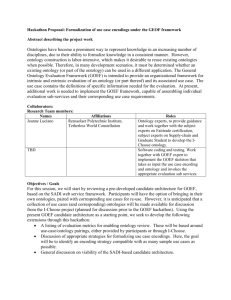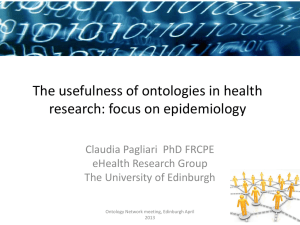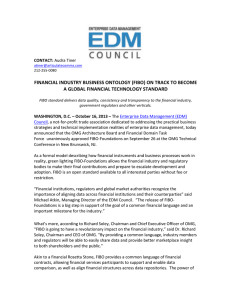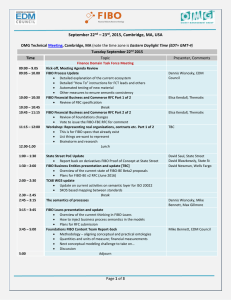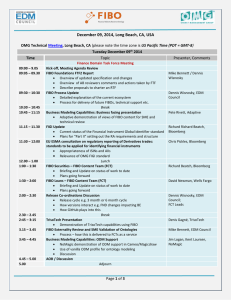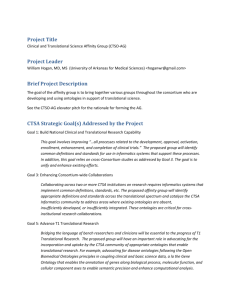Introductory overview of FIBO
advertisement
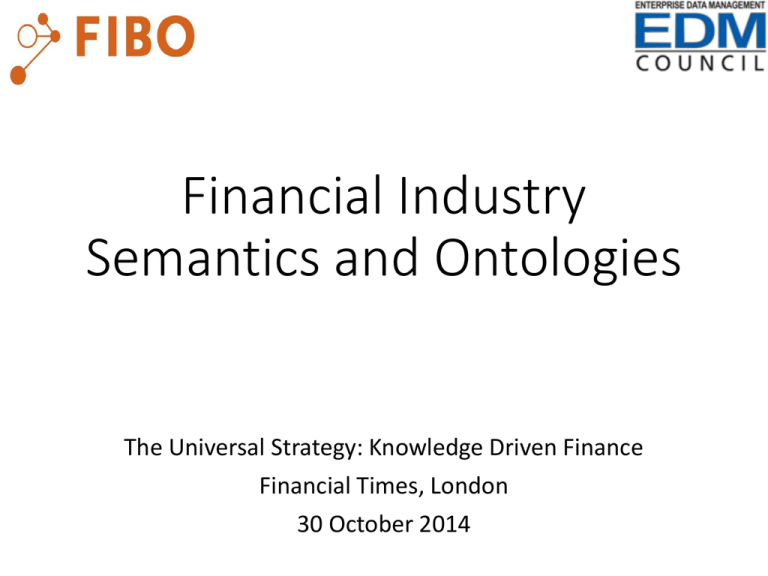
Financial Industry Semantics and Ontologies The Universal Strategy: Knowledge Driven Finance Financial Times, London 30 October 2014 Semantic Challenges "Where is the wisdom we have lost in knowledge? Where is the knowledge we have lost in information?" - T. S Eliot Syntax is not Semantics Meaning is not Truth Approaches to Meaning Rosetta Stone Mayan Language 4 Approaches to Meaning Rosetta Stone Mayan Language • Existence of already-understood terms enabled translation • Semantics grounded in existing sources 5 Approaches to Meaning Rosetta Stone • Existence of already-understood terms enabled translation • Semantics grounded in existing sources Mayan Language • No existing common language to enable translation • Translation was possible only from internal consistency of concepts 6 Rosetta Stone: Semantic Networks • Directed Graph • The meaning at each node is a product of its connections to other nodes • Semantically grounded at certain points in the graph 7 Semantic Grounding for Businesses What are the basic experiences or constructs relevant to business? • • • • • • Monetary: profit / loss, assets / liabilities, equity Law and Jurisdiction Government, regulatory environment Contracts, agreements, commitments Products and Services Other e.g. geopolitical, logistics 8 Where does this lead? • Taxonomy of kinds of contract • Taxonomy of kinds of Rights • Rights, Obligations are similar and reciprocal concepts • Note that these don’t necessarily correspond to data • Semantics of accounting concepts • Equity, Debt in relation to assets, liabilities • Cashflows etc. • Semantics of countries, math, legal etc. 9 Mayan: Internal Consistency • Graph has logical relations between elements • These correspond to the relations between things in reality • Automated reasoning checks the “deductive closure” of the graph for consistency and completeness Mayan: Internal Consistency • Graph has logical relations between elements • These correspond to the relations between things in reality • Automated reasoning checks the “deductive closure” of the graph for consistency and completeness FIBO Ontologies: Conceptual and Operational Conceptual Ontology Use Case neutral Meaning expressed in the “Language of the business” Formally grounded in legal, accounting etc. abstractions Operational Ontologies Classes and properties Use case specific classes, properties Namespaces Optimized for operational functions (reasoning; queries) Annotations Addition of rules Definitions Mapping to other OWL ontologies 12 Developing FIBO Conceptual ontology Shared business meanings 13 Developing FIBO Conceptual ontology Validated by business Shared business meanings 14 Developing FIBO Conceptual ontology Validated by business Expressed logically Shared business meanings 15 Example: Credit Default Swap (CDS) 16 Financial Industry Business Ontology (FIBO) • Business Entities Business Entities • Legal entities, ownership hierarchies, LEI, Securities • Securities • Tradable securities - equity, debt securities, reference data terms • Loans Loans • Retail lending, corporate, credit facilities Derivatives • Derivatives • Exchange traded and over the counter derivative trades, contracts and terms • Market Data Market Data • Date and time dependent pricing, analytics • Corporate Actions Corporate Actions • Corporate event and action types, process Metadata 6/5/2012 • Annotation metadata • Provenance. mapping, rulemaking 17 Using FIBO EXTEND DEPLOY Firm’s Business Conceptual Ontology App App App Actually… EXTEND Firm’s Business Conceptual Ontology DEPLOY App App App Deploying BCO Firm’s BCO Common Logical Data Model Local LocalLDMs LDMs DEPLOY DEPLOY Adapters Operational Operational Operational Ontologies Ontologies Ontologies Triple Store Regulatory Reporting Use Case • Need for “Common Language” • OFR, BoE and others • What do we mean by “language” here? – Bank of England Proof of Concept 21 Regulatory Reporting Current State ? Reports (forms) FORMS REPORTING ENTITY FORMS REGULATORY AUTHORITY 22 Regulatory Reporting Current State ? Reports (forms) FORMS FORMS REPORTING ENTITY REGULATORY AUTHORITY Change in Reporting requirements = Uncertainty • • Redevelopment effort Content of the reports • By each reporting entity • Are we comparing like with like? • For each system and form • Data quality and provenance 23 Regulatory Reporting with Semantics Granular Thing Thing data Contract IR Swap CDS ! Contract Bond IR Swap CDS Common Common ontology ontology REPORTING ENTITY Bond REGULATORY AUTHORITY Data is mapped from each system of record into a common ontology Receives standardized, granular data aligned with standard ontology (FIBO) Reported as standardized, granular data Uses semantic queries (SPARQL) to assemble information Agnostic to changes in forms Changes to forms need not require reengineering by reporting entities 24 Thank you! • Mike Bennett • Semantics Lead, EDM Council • Director, Hypercube Ltd. • www.edmcouncil.org • www.hypercube.co.uk/edmcouncil

